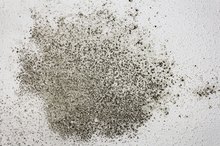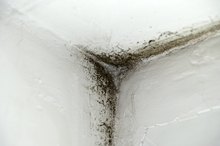Black Mold Symptoms in Infants
Black mold is a serious problem in many homes. It can cover walls and ceilings exposed to too much moisture. According to the University of Minnesota, infants are especially susceptible to the effects of black mold and can develop more severe symptoms. Mold is a toxin and can be a serious threat to an infant’s system. An infant can exhibit several different symptoms.
If you are experiencing serious medical symptoms, seek emergency treatment immediately.
Lung Problems
Because an infant’s respiratory system is immature, his body can't rid itself of the toxins that molds give off. According to Ohio Link, visible mold is a risk factor for respiratory illness and wheezing 1. The wheezing can recur and be frightening for the infant and family. An infant may also suffer from coughing and may even have some difficulty breathing or catching his breath. In addition, black mold can cause respiratory illness such as pneumonia in severe cases. Lung problems in an infant can be a serious health risk. A physician must evaluate the infant immediately.
- Because an infant’s respiratory system is immature, his body can't rid itself of the toxins that molds give off.
- The wheezing can recur and be frightening for the infant and family.
Gastrointestinal Issues
Diseases Linked to Black Mold
Learn More
According to Susan Lillard-Roberts in an article on Mold Survivor, an infant exposed to black mold may suffer from gastrointestinal problems. These problems may include nausea and vomiting. A young infant may refuse to eat and may lose weight as a result. In addition, Lillard-Roberts reports that an infant may also suffer from diarrhea and abdominal pain. These symptoms may last for short periods and return but can also last for longer periods. The longer diarrhea, nausea and vomiting last, the more risk there is of the infant becoming dehydrated. This can be a life-threatening medical condition for an infant, and a physician should evaluate the baby as soon as possible.
- According to Susan Lillard-Roberts in an article on Mold Survivor, an infant exposed to black mold may suffer from gastrointestinal problems.
Rash
According to the University of Minnesota, skin irritations or rashes can occur on the skin of an infant exposed to black mold. Often, the infant’s skin is directly exposed to the black mold, but this is not always the case. A red, bumpy rash can develop on the child’s body. The rash may be painful or irritating. Creams for rashes that you would normally use aren't useful. This rash may sometimes be mistaken for a diaper rash if it occurs in the diaper area. However, if the rash occurs in other places, consult your physician.
- According to the University of Minnesota, skin irritations or rashes can occur on the skin of an infant exposed to black mold.
- A red, bumpy rash can develop on the child’s body.
Related Articles
References
- Ohio Link: Indoor Mold Exposure and its Relationship with Wheezing in Infants
- Mold Survivor: Symptoms of Fungal Exposure
- Amirhosein Ghaffarianhoseini, Husam AlWaer, Hossein Omrany, Ali Ghaffarianhoseini, Chaham Alalouch, Derek Clements-Croome & John Tookey (2018) Sick building syndrome: are we doing enough?. Architectural Science Review,61:3, 99-121.
- American College of Allergy, Asthma & Immunology. Mold Allergy. Reviewed April 23, 2018.
- Centers for Disease Control and Prevention. Fungal Diseases. Reviewed May 6, 2019.
- Centers for Disease Control and Prevention. Mold. Basic Facts. Reviewed December 20, 2017
- Asthma and Allergy Foundation of America. Mold Allergy. Reviewed October 2015.
- Centers for Disease Control and Prevention. Molds in the Environment. Rreviewed December 20, 2017.
- Asthma and Allergy Foundation of America, Mold Allergy
- Centers for Disease Control and Prevention (CDC), Mold, Basic Facts
- Rudert A, Portnoy J.Mold allergy: is it real and what do we do about it?Expert Rev Clin Immunol. 2017 Aug;13(8):823-835. doi: 10.1080/1744666X.2017.1324298. Epub 2017 May 17.
Writer Bio
Kristie Jernigan is a health writer with over 17 years of experience as a medical social worker. She has worked mainly with the elderly population and with children. She holds a Bachelor of Science in psychology and early childhood from East Tennessee State University and a Master of Science in health care administration and gerontology from the University of Phoenix.









